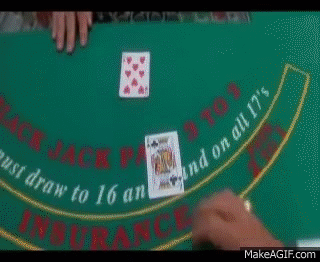Ties and How to Count Cards
How about learning card counting to go with that tie?
A Gambler's Tale:
Vegas Baby! There she is. Your plane sees her too, heads for neon, as if drawn by the same siren that called you here. Your treasure-hunter's spirit is on the casino floor before you even deboard the plane.
When the rest of you does finally catch up, you're looking Rat-Pack right (courtesy of tieroom, of course) and ready to collect. You spot a blackjack table that looks like it owes you. You un-pocket your bankroll--a fat folded-over C that represents more overtime than you care to remember--and settle in, ready to move up a tax bracket...... And by the time you get done blinking, your flipped-out pockets are helping pay the light bill and your spirit has gone to the desert.The End
And the moral of our little loser's tale: Lady Luck is not a booty call (get it). She wants to be courted, see some effort. Here's how to get her to like you.Card Counting 101: Card counting allows a player to track the potential of upcoming hands by simply adding and subtracting as the cards are dealt. As shown below, cards are assigned a +1, -1, or 0.
- 2-6 = +1
- 7-9 = 0
- 10-A = -1
- 9 (zero), 3 (plus one) = +1
- Q (minus 2), K (minus 2) = -2
- 6 (zero), 7 (zero)= 0
- J (minus 1), 2 (plus 1) = 0
Card Counting 102: The running count tracks whether or not the cards that have yet to be dealt are favorable (loaded with tens and face cards) or unfavorable (nothing but single digit numbers). In other words, it lets the player know when their odds of winning an upcoming betting round is at its highest and lowest potential. Example:
- Player A 10,3,7
- Player B Q,K
- Player C 10,6
- Player D 9,9
- Dealer J,2,5
Card Counting 103: The betting system is simple. If the count is negative or even, bet only the minimum table bet. If the count is positive, bet one unit (chip) equal to the count. For instance, a player at a $5 minimum bet table with a count at +2 would bet $10 on the upcoming hand. Now let's put it all together. Example: $5 minimum bet
- Player A 2,3,9
- Player B 10,9
- Dealer 5,4,9
In Conclusion: While this system is relatively simple to grasp, application of the system is not so easy. Dealers deal like lightning so keeping a count can be a bit of mental attrition. But even a rudimentary grasp of counting cards with a lost-in-all-the-dealing-half-known-vague-idea running count is better than a straight up "Guess I'll bet big now?" To really make your tie money, the system needs to be ingrained like a trait. Therefore, practice, practice, practice makes money, money, money as the saying goes. So deal to yourself or download one of the upteen card counting trainer apps (iCount Pro is a great one) that are out there and turn a typical night at the tables from Pesci in Casino...
 ...to Hoffman in Rain Man!
...to Hoffman in Rain Man!
Good luck, PLAYA!
*Entertaining, informing, and inspiring the person behind the tie*










